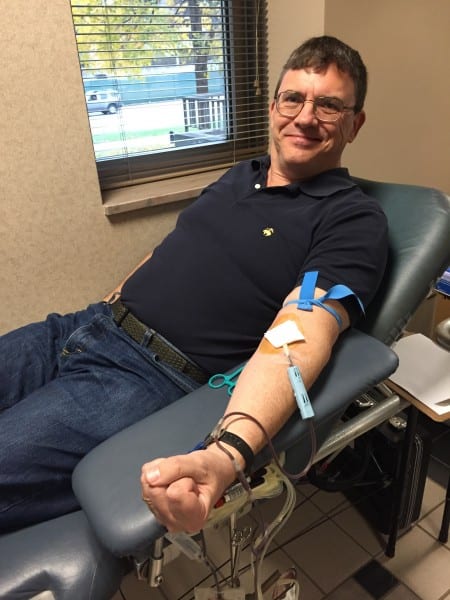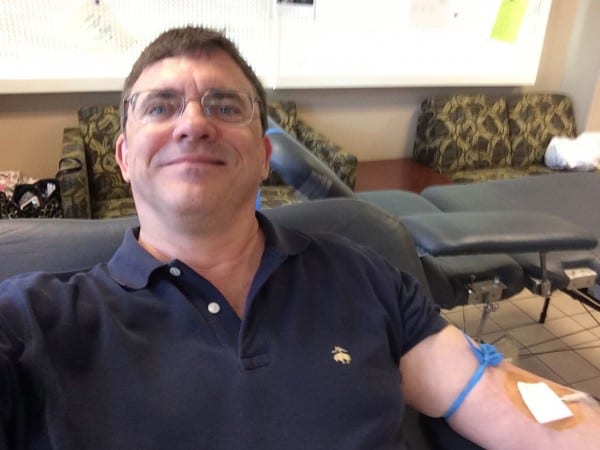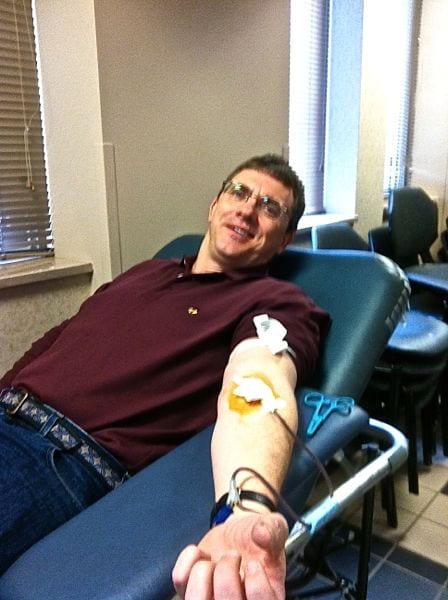THAT SEEMS PRUDENT: All Donated Blood in U.S. Should Be Tested for Zika, F.D.A. Says. “The recommendations are an acknowledgment that sexual transmission may facilitate the spread of Zika even in areas where mosquitoes carrying the virus are not present. Officials also want to prepare for the possibility that clusters of local infection will continue to pop up in parts of the United States for years to come.”
Search Results
SO I DONATED BLOOD TODAY — I skipped the usual photo, since by now you all know what I look like giving blood — but to my surprise there weren’t any Zika questions yet. Soon, I guess, but if they won’t let people who’ve been in Zika areas give blood will there be anyone left?
UPDATE: Missed it by that much. “In response to the Zika outbreak, the American Red Cross is asking people to avoid donating blood if they traveled to Latin America or the Caribbean in the past 28 days.”
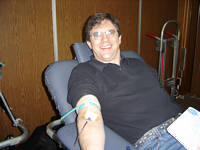
DONATED BLOOD AGAIN TODAY for the UT vs. Florida competition. (Yes, this is an old picture, because I forgot to get them to take one this time. But the process looks about the same). Once again, there were a lot more women donating than men. And once again, the questions they asked were more detailed than the last time. I was talking to Doug Weinstein the other day, when he’d just donated, and we concluded that we’d better keep giving because it seems like we’re pretty much the only ones left who are allowed to donate blood.
Seriously, all these Mad Cow Disease questions — is that really still a thing?
DONATED BLOOD THURSDAY at the Law School blood drive. Some of my students gave, too, but quite a few complained that they’re ineligible because of having lived in Europe. Given that the blood folks are always calling me saying they’re desperately short of blood, I wonder if the standards are too strict.
But then, I’ve been wondering that since the very earliest days of InstaPundit. And as I said then: “In the meantime, I’ll be donating blood more often. If you can, you should too.” It may also lower your risk of heart attack and stroke.

DONATED BLOOD AGAIN TODAY for the Blue/Orange blood drive. The crowd was huge — I had to wait nearly an hour — and one of the students told me that donating blood is now “a fad.” Well, good.
And yeah, this is a recycled photo from a past donation, but it always looks about the same. Besides, recycling is in! And hey, at least I’m not using that photo of Ann Althouse studying that everyone keeps recycling . . . .

DONATED BLOOD AGAIN for the Blue/Orange blood drive. The questions just seem to get longer, but the crowd was good today — and, somewhat unusually, almost all male. Usually it seems to lean the other way.
I don’t know if Tennessee will beat Kentucky again, but either way it’s a win. And yeah, this is a recycled photo from a past donation, but it always looks about the same. And hey, it seems like everybody’s recycling imagery these days anyway. . . .
SO I DONATED BLOOD TODAY — no picture, because, once again, I neglected to take a camera. On the other hand, I’ve probably gotten all the mileage I can out of the blood-donation photo op already. This time it was at my gym where they were having a blood drive, and, as is often the case, I was the only male donating. If I were single, I think I’d donate more often — there are lots of young, attractive women there, they’re presumptively healthy and probably somewhat altruistic, and it’s natural to strike up a conversation since they keep you waiting a lot. (I chatted with a lovely oncology nurse today). I didn’t really start giving blood until after I got married, so this is all academic to me, but you single guys out there take note. And besides, it’s embarrassing that men are so underrepresented.
 BLOOD-BLOGGING: I donated blood again for the Blue/Orange blood drive. (This picture is actually from last year because — yes, it’s humiliating to admit — I didn’t have a digital camera on me. But it looked about the same, except that I was wearing a Tennessee Law Review t-shirt this time.)
BLOOD-BLOGGING: I donated blood again for the Blue/Orange blood drive. (This picture is actually from last year because — yes, it’s humiliating to admit — I didn’t have a digital camera on me. But it looked about the same, except that I was wearing a Tennessee Law Review t-shirt this time.)
As I’ve noted before, the extremely strict rules on blood donation nowadays mean there’s often a shortage of donors. I try to give whenever I can to help make up for that, and I encourage you to do the same if you’re eligible to give blood.
 I DONATED BLOOD TODAY, as part of the Blue/Orange blood drive competition with Kentucky. Tennessee had a lead of well over 100 pints, meaning that we’ve got a decent chance at winning something this weekend, anyway. . . .
I DONATED BLOOD TODAY, as part of the Blue/Orange blood drive competition with Kentucky. Tennessee had a lead of well over 100 pints, meaning that we’ve got a decent chance at winning something this weekend, anyway. . . .
Turnout was very good, and once again I was interested to see that the sex ratio — once skewed heavily toward women — seemed to have evened out. The blood folks said that was their impression, too. Best button: “Phlebotomists have bloody good ideas!”
The list of questions and exclusions seems to get longer every time I do this. As I’ve noted here before, I wonder if all these exclusions might not cost as many lives as they save. Since I’m one of the few people I know who’s eligible to give blood, I try to do it a couple of times a year, since it’s got to come from someplace.
UPDATE: Reader D. Norwood writes: “As the parent of 2 immune deficient children who are alive today because of regular infusions of a blood product (gamma globulin), I want to thank you for donating blood. You literally saved lives today and 2 of those lives are very precious to me.”
If you can donate, it’s good to do so. We take blood availability for granted but, like a lot of things that we take for granted, it’s only there because people do what’s necessary.
I DONATED CONVALESCENT PLASMA FOR MOST OF A YEAR, SO I HOPE SO: Study: Blood plasma may be effective against COVID-19 when used correctly. “Blood plasma collected from people who have recovered from COVID-19 works well as a treatment for those who develop serious symptoms from the virus, a study published Monday by JAMA Internal Medicine found. To be most effective, however, the plasma, administered via transfusion, must be initiated early in the course of the disease, in hospitalized patients, before they require high levels of supplemental oxygen or become hypoxic, the researchers said.”
Yes, most Covid treatments work better if you administer them before people are actually dying.
SOLVING THE BLOOD SHORTAGE BY draining the dead? “Roughly 15 million pints of blood are donated each year by approximately 9.2 million individuals. Over the course of the same year, about 2.6 million Americans will — sadly — pass away. If hospitals were to harvest the blood from a third of those people, roughly 4.5 million liters would be added to the reservoir. . . . Draining the blood from a body is hardly out of the ordinary; it’s actually a regular part of the embalming process. To prepare a dead body for funeral services and eventual burial or cremation, morticians pump out all of the blood and interstitial fluids and replace them with an embalming solution, typically containing formaldehyde and methanol. Would it not make more sense to remove the blood at the hospital soon after death, rather than let it all go to waste?”
BLOOD SHORTAGES IN KNOXVILLE: I’ve donated twice this year; guess I’ll have to do it again soon. I’m afraid this problem is more general, though.
DEMOCRATS PROVIDE COMIC RELIEF: Bad blood meets cold cash: Say, whatever happened to “Swifties Against Youngkin”?
To Terry McAuliffe, it must have seemed too good to check. Unfortunately for Democrats, he didn’t. McAuliffe and his campaign tried to make hay over Glenn Youngkin’s involvement in the fight over Taylor Swift’s publishing rights, in which he worked with former Swift business partner Scott Samuel “Scooter” Braun. They created “Swifties Against Youngkin,” complete with ad buys and merchandising, as The Verge reported on Tuesday. . . .
That seemed too good to be true, right? Apparently it was, because two days later, Team McAuliffe and Virginia Democrats memory-holed the entire operation. . . .
What did happen? Well, a quick look at Open Secrets’ donor records shows one Scott Samuel “Scooter” Braun to be a major contributor to, um … Democrats. In the past few cycles, Braun appears to have donated well into six figures for candidates like Hillary Clinton, Kamala Harris, Cory Booker, and Tammy Duckworth, among others. There doesn’t appear to be a single Republican among Braun’s recipients .. not even Youngkin.
Braun also donates heavily to state Democratic parties. For instance, he kicked in a $4,113 donation to the Democratic Party of Virginia almost exactly a year ago, which qualifies as this current election cycle in the commonwealth. At least for now there don’t appear to be any donations directly to McAuliffe, but then again, we don’t have access to any recent activity. It’s at least possible that McAuliffe and Virginia’s Democratic Party were using Braun’s money to demonize Youngkin for working with Braun himself.
Heh.
SO I DONATED CONVALESCENT PLASMA EARLIER TODAY. The research on it is spotty, but they’re using it a fair bit around here and seem to think it helps, and I have antibodies to spare so what the hell. The procedure was painless — much less unpleasant than I expected — and took about 45 minutes, not counting the paperwork. They take out blood, filter out the plasma, then replace the red cells and enough saline to make up the volume. People say it’s cold, and I could tell, but they put a heated blanket on me so it was fine. I’ll be able to go back and give my usual whole blood in a month, but I figured this was worth doing.
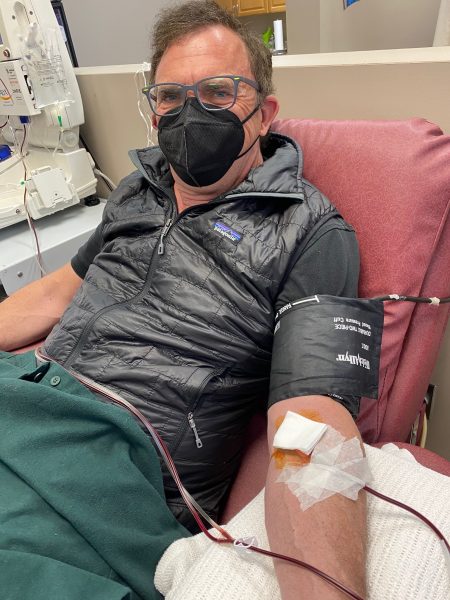
(Bumped, to encourage you to donate plasma, or blood, or whatever. Robert Heinlein would approve.)
SCORE ANOTHER ONE FOR ROBERT HEINLEIN: First results from human young blood rejuvenation trial expected.
Dracula was on to something. The idea that blood from the young can rejuvenate an ageing human body might not be too far from the truth – but no biting is required.
Next year we’ll see the first results from a trial that has given young blood to people with mild to moderate Alzheimer’s in the hope that it will improve their symptoms.
There’s good reason to think it will. Years of animal experiments have shown that an infusion of young blood in older mice can improve their cognition, physical endurance and the health of several organs. It even makes them look younger.
The first few people to trial the procedure got their “taste” of young blood in 2014. It came in the form of a transfusion of blood donated by volunteers aged 30 or younger.
The team behind the trial hopes to see immediate improvements in cognition, but Tony Wyss-Coray at Stanford School of Medicine in California, who is leading the study, cautions that the procedure is very experimental. For that reason, it’s probably best to avoid private clinics that have already started offering to turn back the years in a similar manner.
Well, I suppose that depends on how urgently you need treatment.
GOOD EXAMPLE: Buffalo woman thanks blood donors for saving her life.
A Buffalo woman wants to thank the people who donated the blood that saved her life and she encourages others to give blood.
“If it weren’t for the blood transfusions I really would not be here today,” said Nataka Morris, from Buffalo.
News 4 is teaming up with the American Red Cross for the 100 Days of Summer, 100 Days of Hope Blood Drive this week.
Morris told News 4 that eight months ago she had to take a medical leave of absence from Buffalo State College.
“I couldn’t eat, I could hardly sleep,” said Morris.”I wasn’t any mood to move around or go anywhere.”
Her stomach pains quickly became worse and she was admitted to Sister’s Hospital in November. Tests showed she has Crohn’s Disease.
“I was continuously hemorrhaging, which is why I needed the blood transfusions,” she said.
Morris had 20 blood transfusions in six weeks as doctors tried to save her life. She was in and out of the ICU three times but the transfusions kept her alive.
“I thank whoever donated blood because if it weren’t for the donated blood, my child wouldn’t be here today,” said Janice Tigg, Morris’ mother.
It’s good to donate if you can.
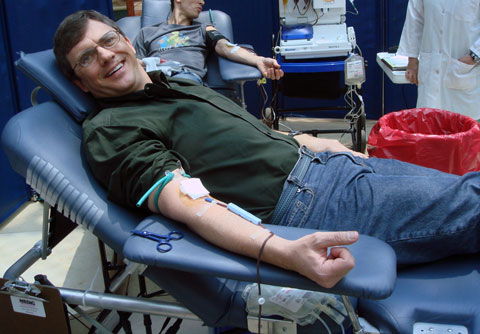
SO MY MEMORIAL DAY ACTIVITY WAS GIVING BLOOD: I missed the blood drive at the law school this spring, and I try to give twice a year, given that under the new, stricter rules I’m one of the relatively few people who can give blood these days. They had the blood drive set up at the mall, so I donated while the Insta-Wife and Insta-Daughter shopped for swimsuits. (They scored big at Guess.) As I’ve noted before, the questionnaire gets longer and longer, but the Medic folks did a pretty good job of moving me through quickly. Unlike some of my experiences donating at the University, the crowd here was more than half male. Then again, the sex-ratio has evened out the last couple of times I’ve donated at school, too.
If you’re eligible, consider donating — I’m not really kidding about the shortage of donors these days.
UPDATE: Amusing caption: “Already I feel the power of the nanobots coursing through my veins! Soon I will be fit to sire a race of immortal robot lawyers.” But one that comes years after the fact. . . .

JUST GAVE BLOOD as part of the annual Blue/Orange blood drive competition with the University of Kentucky. The list of questions they ask just keeps getting longer, and I continue to wonder how much good (or harm) it’s doing, given that as a regular donor I get plaintive “we’re short of blood” calls on a regular basis now. (More on this here and here.) At any rate, they’re screening out so many people that I encourage everyone who is eligible to donate — there aren’t that many of us left.
One interesting observation: This is the first time I’ve donated on campus where there were more men than women giving. Usually it’s quite lopsided in the other direction. One of the techs there told me that it’s been that way this year; no idea why.
 I GAVE BLOOD at the law school blood drive right before my Constitutional Law class. I’m not sure how good an idea that was. Giving blood never makes me dizzy or faint, but I was just a touch lightheaded — it was sort of like having downed a shot right before class. For all I know, it was an improvement. . . .
I GAVE BLOOD at the law school blood drive right before my Constitutional Law class. I’m not sure how good an idea that was. Giving blood never makes me dizzy or faint, but I was just a touch lightheaded — it was sort of like having downed a shot right before class. For all I know, it was an improvement. . . .
Aside from my secretary (who had donated just before me, and who kindly snapped this picture) and one male student, the crowd donating and waiting was entirely female. I don’t know if that’s representative or not, but it seems as if every time I donate on campus it’s that way.
Anyhow, there’s apparently a non-trivial blood shortage in most of the nation, and even those places with plenty on hand are having to send some of theirs elsewhere to make up the difference.
Part of the reason may be (as I blogged here and here back when InstaPundit was young) that they’re getting more and more picky about who they’ll take blood from. In particular, they seem extraordinarily worried about mad cow disease, with ever-more-stringent limits on blood donation by people who have spent time in the UK. Perhaps the reasons for that are better than I realize (which is a bit worrisome, if so), but I wonder how many lives it’s saving, versus lives potentially lost because of blood shortages. Has anyone looked into that lately?
In the meantime, I guess the rest of us in the ever-dwindling group of approved donors should roll up our sleeves. It’s virtually painless, and no big deal. Plus, I got a free cookie!
HMM: The Case For Transmissible Alzheimer’s Grows.
It is important – imperative – to emphasize that transmissible does not equal contagious. There is absolutely no evidence that people with dementia can spread their disease casually to people around them. Even donated blood appears to be safe, as no association with blood transfusions and Alzheimer’s Disease has ever been detected.
Rather, in the course of some neurological surgeries – and perhaps certain kinds of medical exams – prions may become lodged on equipment. And there is a chance this equipment could transmit the disease. Organ donation protocols may also warrant some review. It was already known that donations of dura mater, a tough brain covering, have transmitted Aβ to young people in the past.
And I wonder. Since Alzheimer’s Disease is so common, and we have not (to my knowledge) been looking for Alzheimer’s caused by surgical or other medical procedures that access eye or neural tissue — particularly in patients for whom the appearance of Alzheimer’s would not be surprising — is it possible that we are underestimating the transmission potential of this disease, and that such events are less rare than we would guess?
I don’t know, but I don’t like it.
NEWS ORGANIZATION DOES ACTUAL PUBLIC SERVICE: Hell would freeze over before CNN or The New York Times followed suit, but John Solomon’s Just The News is doing the right thing simply because it’s the right thing to do: “Just the News partners with anti-Semitism nonprofit to raise funds for Hamas massacre survivors”
“Just the News is partnering with the Combat Antisemitism Movement nonprofit to raise funds for survivors of the Hamas terrorist attack on Israel, with major donors promising to match dollar-for-dollar each contribution made by the news organization’s readers, viewers and listeners.
Proceeds will be donated to the Israel Emergency Support Fund, which has been set up to raise money for frontline responders in Israel, including the Magen David Adom, the country’s national emergency medical, disaster, ambulance and blood bank service, and the Soroka Hospital of Beersheva, closest major medical center to where last Saturday’s attacks occurred in southern Israel. Proceeds will also go to two kibbutzes where horrible massacres occurred.”
You can make a donation here.
I DON’T MISS THE 1970s: On this day in 1974, members of an urban guerrilla group calling itself the “Symbionese Liberation Army” dragged 19-year-old Patty Hearst from her Berkeley apartment. Ms. Hearst was tossed into the trunk of a car; her fiancé, who may have tried to prevent the kidnapping, was left beaten and bloodied.
The SLA members had learned of the young heiress’s whereabouts by reading the San Francisco Chronicle’s “Society” page. In announcing her engagement, it listed her address—2603 Benvenue Avenue, Apartment 4—which happened to be not far from SLA headquarters. What could be more convenient?
The original plan was to use Hearst to gain the release of two SLA members who had been arrested for the notorious murder of Oakland school superintendent Marcus Foster. That didn’t work.
Plan B was to press the Hearst family to give millions to feed California’s poor. That did work … initially at least. The Hearst family donated $2 million worth of food to an operation dubbed “People in Need.” Alas, that project descended into chaos, with more not-so-well-behaved people showing up for free food than had been anticipated. Dissatisfied, the SLA declined to release Ms. Hearst.
During this period, Ms. Hearst was being kept in a closet. When she was let out to eat, she was blindfolded.
But a funny thing happened. The SLA periodically released tape recordings that included statements from Ms. Hearst. In these “communiqués,” Hearst began sounding increasingly sympathetic to her captors. In one early message, she said, “I’m not being starved or beaten or unnecessarily frightened.” (This didn’t match up well with her later testimony that she had been repeatedly sexually abused and threatened with death during her captivity.)
A few more weeks into her ordeal, she became critical of her family. She even complained about the food her father had provided to “People in Need”: “It sounds like most of the food is low quality. No one received any beef or lamb. Anyway, it certainly didn’t sound like the kind of food our family is used to eating.”
Finally, after about two months, she recorded a rant in which she claimed that “the corporate state” is about to murder Black and poor people “down to the last man, woman, and child.” The “corporate state” was “about to totally automate the entire state industrial state” and remove “unneeded people.”
“I have been given the choice of one: being released …, or two: joining the forces of the Symbionese Liberation Army and fighting for my freedom and the freedom of all oppressed people. I have chosen to stay and fight. I have been given the name Tania after a comrade who (more…)

